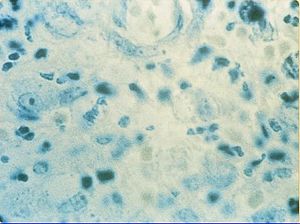Donovanosis
| Granuloma inguinale | |
|---|---|
 |
|
| Donovanosis | |
| Classification and external resources | |
| Specialty | infectious disease |
| ICD-10 | A58 |
| ICD-9-CM | 099.2 |
| DiseasesDB | 3888 |
| MedlinePlus | 000636 |
| eMedicine | derm/172 |
| MeSH | D006100 |
Granuloma inguinale (also known as donovanosis) is a bacterial disease caused by Klebsiella granulomatis (formerly known as Calymmatobacterium granulomatis) characterized by ulcerative genital lesions. It is endemic in many less developed regions. It is also known as donovanosis, granuloma genitoinguinale, granuloma inguinale tropicum, granuloma venereum, granuloma venereum genitoinguinale, lupoid form of groin ulceration, serpiginous ulceration of the groin, ulcerating granuloma of the pudendum, and ulcerating sclerosing granuloma.
The disease often goes untreated because of the scarcity of medical treatment in the countries in which it is found. In addition, the painless genital ulcers can be mistaken for syphilis. The ulcers ultimately progress to destruction of internal and external tissue, with extensive leakage of mucus and blood from the highly vascular lesions. The destructive nature of donovanosis also increases the risk of superinfection by other pathogenic microbes.
Small, painless nodules appear after about 10–40 days of the contact with the bacteria. Later, the nodules burst, creating open, fleshy, oozing lesions. The infection spreads, mutilating the infected tissue. The infection will continue to destroy the tissue until treated. The lesions occur at the region of contact typically found on the shaft of the penis, the labia, or the perineum. Rarely, the vaginal wall or cervix is the site of the lesion. At least one case in India led to partial autoamputation of the penis. The patient tested positive for HIV-2 and had been infected for six years.
...
Wikipedia
